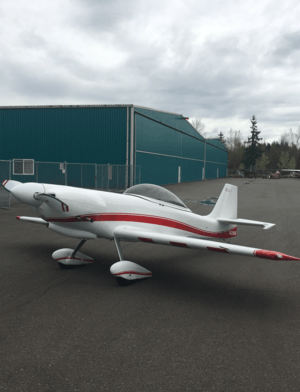Aircraft Technologies Acro 1
The Aircraft Technologies Acro 1 is an American aerobatic homebuilt aircraft that was designed by Fred Meyer and produced by Aircraft Technologies of Lilburn, Georgia. When it was available the aircraft was supplied as a kit or in the form of plans for amateur construction.[1] Neither plans nor kits are available anymore and the aircraft is out of production.[2]
| Acro 1 | |
|---|---|
 | |
| Role | Homebuilt aircraft |
| National origin | United States |
| Manufacturer | Aircraft Technologies |
| Designer | Fred Meyer |
| First flight | 1993 |
| Status | Production completed |
| Number built | At least three (2013) |
| Unit cost |
US$22,900 (Kit, less engine and propeller, 1998) |
Design and development
Designed as a high-speed, long-range cross country and aerobatic aircraft, the Acro 1 features a cantilever low-wing, a single-seat enclosed cockpit under a bubble canopy, fixed conventional landing gear and a single engine in tractor configuration. The aircraft is stressed to +/-15g.[1]
The aircraft is made from graphite and fiberglass composites. Its 20.00 ft (6.1 m) span wing has a wing area of 75.00 sq ft (6.968 m2) and has no flaps. The acceptable power range is 100 to 210 hp (75 to 157 kW) and the standard engine used is the 200 hp (149 kW) Lycoming IO-360 powerplant which gives it a cruise speed of 220 mph (350 km/h). A fuel capacity of 47 U.S. gallons (180 L; 39 imp gal) provides a range of 1,000 mi (1,600 km).[1]
The Acro 1 has an empty weight of 780 lb (350 kg) and a gross weight of 1,250 lb (570 kg), giving a useful load of 470 lb (210 kg). With full fuel of 47 U.S. gallons (180 L; 39 imp gal) the payload is 188 lb (85 kg).[1]
The manufacturer estimates the construction time from the supplied kit as 700 hours.[1]
Operational history
By 1998 the company reported that one example had been flown.[1]
In November 2014 three examples were registered in the United States with the Federal Aviation Administration.[3][4]
Specifications (Acro 1)
Data from AeroCrafter[1]
General characteristics
- Crew: one
- Length: 17 ft 0 in (5.18 m)
- Wingspan: 20 ft 0 in (6.10 m)
- Wing area: 75.00 sq ft (6.968 m2)
- Empty weight: 780 lb (354 kg)
- Gross weight: 1,250 lb (567 kg)
- Fuel capacity: 47 U.S. gallons (180 L; 39 imp gal)
- Powerplant: 1 × Lycoming IO-360 four cylinder, air-cooled, fuel injected four stroke aircraft engine, 200 hp (150 kW)
- Propellers: 2-bladed constant speed propeller
Performance
- Maximum speed: 245 mph (394 km/h, 213 kn)
- Cruise speed: 220 mph (350 km/h, 190 kn)
- Stall speed: 58 mph (93 km/h, 50 kn)
- Range: 1,000 mi (1,600 km, 870 nmi)
- Service ceiling: 25,000 ft (7,600 m)
- g limits: +/-15
- Rate of climb: 3,000 ft/min (15 m/s)
- Wing loading: 16.67 lb/sq ft (81.4 kg/m2)
See also
Aircraft of comparable role, configuration and era
- Giles G-200
- Rihn DR-107 One Design
- Van's RV-3
Related lists
References
- Purdy, Don: AeroCrafter - Homebuilt Aircraft Sourcebook, Fifth Edition, page 109. BAI Communications, 15 July 1998. ISBN 0-9636409-4-1
- Experimental Aircraft Association (2013). "Acro 1". Archived from the original on 23 February 2013. Retrieved 2 December 2013.
- Federal Aviation Administration (4 November 2014). "Make / Model Inquiry Results, Acro 1". Retrieved 4 November 2014.
- Federal Aviation Administration (4 November 2014). "Make / Model Inquiry Results, Acro One". Retrieved 4 November 2014.